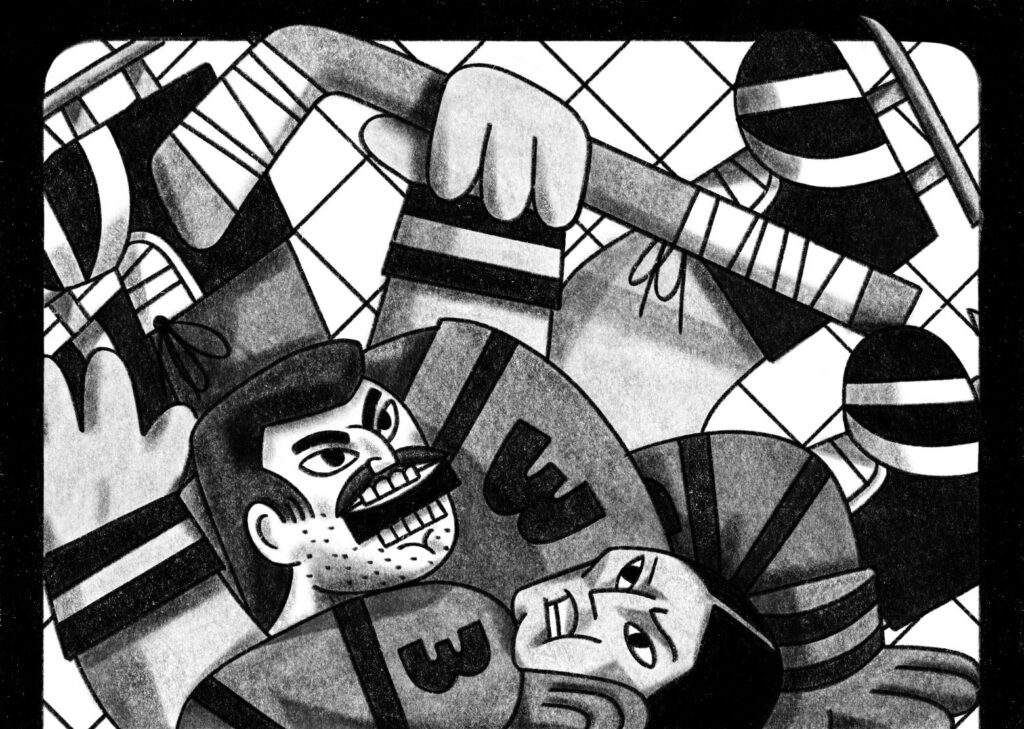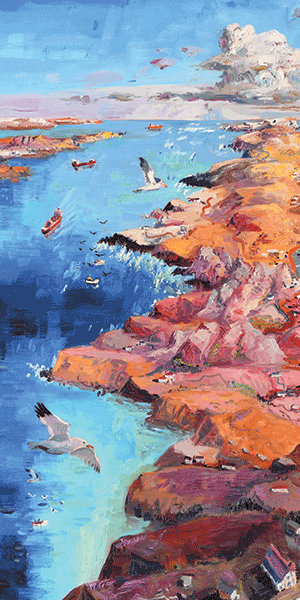Christophe Bernard’s debut novel starts out simply enough. In a small-town bar, Monti Bouge picks a fight with the new mailman. During a hockey game a dozen years earlier, Monti had stopped a puck with his teeth and gone flying into the net with his opponent. The mailman refereed that game and decided the goal should count. But this is Gaspésie, the place where rural Quebec meets the Maritimes and the locals “lay it on thick,” turning accidents into epics and rumours into legends. The disputed goal sparks a multi-generational feud, as binge-drinking characters spur one another to new heights of excess. The prose follows suit, lurching between dialect and the specialized vocabulary of a thesaurus addict.
When it was first released in French, in 2017, The Hollow Beast drew comparisons to Thomas Pynchon, David Foster Wallace, and Victor-Lévy Beaulieu. Translating it into English must have been a masochistic endeavour, but Lazer Lederhendler, who already has a Governor General’s Award to his name, proves up to the task. His rendition retains the energy and impenetrability of the original, though the end result is also hard to judge. Is this book a trippy masterpiece or a self-indulgent nightmare? At the very least, it’s ambitious.
The action alternates between two timelines. The more enjoyable follows Monti from the early twentieth century to the age of television. The orphan turned folk hero takes revenge on his mailman nemesis by ordering encyclopedias and bags of gravel delivered to his cabin in the woods. Later, Monti heads for the Klondike but stops “someplace east of Timmins,” confused by all the English and convinced he must have arrived. He strikes it rich anyway in a high-stakes poker game that includes shares in the Yukon liquor company. The contemporary scenes follow Monti’s tortured grandson François, a doctoral student plagued by hallucinations who decides to take a taxi from Montreal back to Gaspésie. His brother Yannick awaits him at a house party where guests blast the fridge with a shotgun and set one another on fire with hairspray. As if that weren’t enough, there is a magical moose-like beast made of rainbows and a subplot involving a warlock and the Mafia.

Translating the brawl and subsequent events must have been a masochistic endeavour.
Gwendoline Le Cunff
Even more ornate than the plot is Bernard’s prose, which recasts Mounties as “cute red-hatted centaurs” and presents François “sliding across the floor, like a sort of meditative curling rock.” Where the original employs Gaspé dialect, Lederhendler cleverly delivers a Maritime spread of “yous.” The results are often amusing but can be tortuous to follow, particularly as many of the characters are crazy, sloshed, or both. (Yannick, the rascal, is on acid.) The most gratuitous section occurs right after the prologue. François wanders around a hospital where he meets “a fairy godmother wearing a pareu that danced in her wake” (a psychiatrist, it turns out) and a “troll with an egg-shaped skull bedecked with blood” (probably another patient). After crawling into bed with an old man on a respirator, François flees the hospital and runs into a drug-addled acquaintance who stabs him with a nail clipper. It’s not clear that any of this matters.
With persistence, though, one can tap into the author’s manic rhythm and admire the density of the world he creates. A native of Carleton-sur-Mer, Bernard depicts the fictional town Saint-Lancelot-de-la-Frayère as simultaneously a backwater and a civilization that follows its own set of baroque rules. A character like Steeve may be “a prime specimen of oaf,” but he belongs as part of an elaborate network of third cousins. The “Montreal dude” who crashes the party with his “big-city swagger” does not. As one local observes, “He wouldn’t last long at the far end of the Tapps’s road at Saint-Maurice-de-l’Échouerie.” The reference sounds invented, an example of how small places remain illegible to outsiders. But it’s an allusion to a 1909 fishermen’s revolt led by Joseph Tapp. Bernard’s accomplishment is to marry such specificity with the region’s banal modernity, as its inhabitants turn up the Metallica and buy condos in Florida.
If there is a real “beast” here, it’s alcohol. Monti’s family receives a bottle of Yukon a week, a consequence of that “Klondike” poker game, and they drink it. This substance abuse is plenty of fun, yet it also seems to fuel the decay of the family and the town. So do the hypermasculine pissing contests. As one bartender observes, “The men of La Frayère — not the women — lived in two worlds.” One is softened by feminine presence. In the other, “they were alone among themselves, a situation liable to get out of hand.” Bernard manages to both inhabit this over-the-top universe and reveal its limitations. His presentation of the Mi’kmaq character Billy Joe Pictou, who scores the initial goal against Monti, is more questionable, saved from stereotype largely by the ridiculousness of everyone else. There’s also a dark scene of sexual assault that risks appearing to be just another escapade.
The Quebec literati lined up behind Bernard six years ago, awarding him the Prix des libraires and praising his linguistic inventiveness. Given the scattered allusions to Homer’s Odyssey, which Monti borrows from the library but never actually reads, it’s tempting to follow suit and praise The Hollow Beast as a Joycean feast. But like the “brain-wrecking alcohol” that Monti swills, Bernard’s creation requires a strong constitution to be enjoyed. His technical mastery has generated all kinds of complex flavours, so long as one can stomach the initial shock of the taste.
Amanda Perry teaches literature at Champlain College Saint-Lambert and Concordia University.

